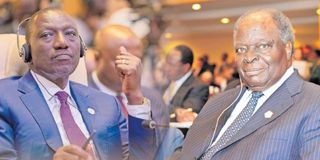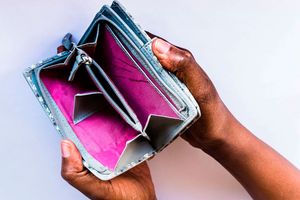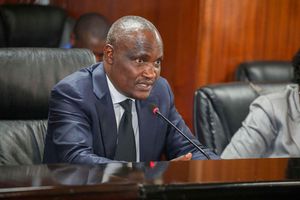
President William Ruto and former president Mwai Kibaki.
Deputy President Kithure Kindiki might have stirred the hornet’s nest with his baffling claim that President William Ruto has achieved more in his first two years than President Mwai Kibaki did in his first five years.
The social media reaction was scathing, with many accusing the Prof Kindiki of being wide off the mark. Mr Kibaki, who completed his two terms in 2013 and died nine years later, is widely acknowledged for swiftly pulling Kenya from the brink of economic collapse and destruction of infrastructure and institutions inherited from the President Daniel arap Moi’s years 24-year reign.
Dr Ruto, by contrast, has in first two years struggled to reset the economy on an even keel after inheriting crippling foreign debt and a dilapidated Treasury from the two-term reign of President Uhuru Kenyatta (2013-2022), whom he served as Deputy President.
Some comments suggested that the only measure on which Dr Ruto out-performed Kibaki was in abductions and other human rights abuses by State security agents. Many opined that the Deputy President, a Professor of Law, had reduced himself to the level of the uneducated sycophants forever out to flatter the president.
However, the immediate headlines might not have fully captured the essence of what Prof Kindiki, addressing a large delegation from his Tharaka Nithi County at his official residence, was trying to communicate.
A transcript of his comments shows the Deputy President trying to explain the intricacies of macro-and micro-economics to a large gathering of more than 1,000 people bused in from his home country, many of whom were clearly at sea.
His basic theme was that the Ruto administration has in two years fixed the basic economic fundamentals — stabilised the shilling, inflation, interest rates and so on — which he claimed, that Mr Kibaki did not manage until the end of his first five-year term.
That contention is not supported by official data form the Kenya National Bureau of Statistics, which shows rapid economic recovery as soon as President Kibaki took over.
Prof Kindiki went on that after fixing the economic fundamentals within its first two years, the Ruto administration is now on course to deliver on, over the next two years, “what is music to our years. Household, incomes, job creation, microeconomic transformation of real sectors where our people derive their livelihoods from”.
Yet, the Deputy President seemed to be undermining his own arguments after having initially said that the that the progress recorded in Mr Kibaki’s early years did not mean much.
He had pointed out that President Kibaki Inherited from an economy growing at less than 1 per cent annually rising to 7 per cent at the end of his first term: “But people don’t eat growth. They were asking Kibaki ‘you’re telling us about growth, about GDP (Gross Domestic Product), but we don’t see anything’. The same questions people are asking today”.
He went on to compare the problems President Kibaki faced at inception such as ill-health, opposition challenges, and a divided coalition with what Dr Ruto has faced.
“The first year he had terrible opposition from the outside” he said in reference to challenges mounted opposition chief Raila Odinga, “The second year terrible opposition from inside his government”, in reference to the events leading to impeachment of Prof Kindiki’s predecessor, Rigathi Gachagua.
Beyond economics, there are quite a number of parallels that can be drawn up between Ruto’s young administration and the early years of the Kibaki presidency.
Both came to power at the head of unwieldly coalitions that were essentially gatherings of ethnic chieftain — Mr Kibaki’s National Rainbow Coalition (Narc) and Dr Ruto’s Kenya Kwanza alliance.
Within the first couple of years, President Kibaki’s collation had fractured as key figures who had come in after bolting from Moi’s KANU ahead of the December 2002 polls, rejected his attempts to push through a contentious new constitution. Mr Odinga from within, and Mr Uhuru Kenyatta and Mr Ruto from Kanu, led the ‘No’ camp during the 2005 referendum on the proposed Supreme law.
On losing the referendum, President Kibaki dissolved the cabinet, to reconstitute it afresh sans renegades from the Raila camp.
Prof Kindiki reminded his audience of this history during the gathering last Wednesday, January 29.
“President Kibaki’s first term was terrible. It was difficult. He was unwell and some characters around him were the ones running government, making decisions, making unpopular pronouncements. In two years he became the most hated, most unpopular president. In 2005 he brought a referendum and was defeat. Do you remember Banana and Orange (the symbols of the referendum vote)? He dissolved his entire Cabinet and was left with the old man, [Vice President] Moody Awori. He lost a referendum, yet he remains the most consequential former president,” said Prof Kindiki.
Banana and Orange were symbols allocated by the Electoral Commission to the respective ‘Yes’ and ‘No’ for the referendum campaigns. Mr Odinga and his ‘No’ colleagues — including Mr Ruto, present Prime Cabinet Secretary Musalia Mudavadi and Wiper Party leader Kalonzo Musyoka, (presently the key principal of the opposition Azimio coalition after Mr Odinga decamped to Ruto’s side) — came to adopt the symbol on formation of the Orange Democratic Movement.
Prof Kindiki went on to recall that Dr Ruto faces similar challenges as Mr Kibaki having to push through unpopular policies as part of an economic revival process.
“What is happening around here is something that has happened before. Any transformational leader who has an idea on what to do about key sectors has to make unpopular decisions. Populist leaders make popular decisions,” he said.
He then went on to give the example of universal health care, which he said wasn’t a Kenya Kwanza invention. Kibaki had intended to introduce the same concept when Charity Ngilu was minister for Health, but backed down under public pressure over proposed increments in payroll contributions.
Uhuru, too was also keen on the idea, but in his first term did not have the stomach to push through unpopular new levies. He sat on it, said Prof Kindiki, intending to bring it back in his second term when he would not be seeking re-election.
In 2018, Mr Kenyatta announced his Big 4 Agenda, with universal health cover as key component, when Cecily Kariuki was Health Minister. But again, he retreated in the face of opposition to new levies.
Prof Kindiki’s contention was that it was only Dr Ruto who had the gumption to push through universal health coverage despite stiff opposition, knowing that ultimately it would be a game-changer.
It was in that regard that Prof Kindiki contended that Dr Ruto had achieved more than Mr Kibaki.
“What President William Samoei Ruto has done in two years, it took Kibaki five years. Ruto is on the right track to improving our economy,” the Deputy President said.
“A good transformative leader is not always popular, but popularity comes at the right time. Let us give President William Samoei Ruto time to deliver.”
The jury is of course still out on whether Ruto’s legacy projects, mainly the most controversial Universal Health Cover and Affordable Housing Programme, will come to work as intended.
It is clear that in his address to a captive audience where there was no room for discussion, Prof Kindiki ignored some key fundamentals.
His suggestion that Dr Ruto in two years achieved more than President Kibaki in five years is not backed by any known data.
While the legacy or accomplishments of government can be faithfully measured by hard statistics on economic and social factors, there are many nuanced issues that also come into play, many around politics, security, stability and even approval ratings.
President Kibaki indeed had some difficult period, lauded for economic recovery and delivering on the 2010 constitution, but forever tainted but the flawed mandate of the suspect 2007 re-election victory and the ensuing descent into deadly post-election violence.
But most measures, however, Mr Kibaki is widely recognised as the best president Kenya ever had. He is ranked against founding father Jomo Kenyatta, who presided over enviable economic growth working state institutions, but with a record marred by institutionalized tribalism and corruption.
The second president, Daniel Moi, followed Jomo Kenyatta’s Nyayo (footsteps); in driving corruption and tribalism to new heights, but also presiding over economic devastation and destruction of roads and other infrastructure, and wholesale looting of state corporations.
He is however remembered, like Mzee Kenyatta, of running a fairly stable and peaceful regime, albeit in the one-party dictatorship where dissent was ruthlessly crushed; as well as rapid expansion of education facilities across the country.
President Kibaki, who had served as President Moi’s deputy in his decade, came to office with the mandate to reverse the rot of the Nyayo regime, and he did so impressively without forever blaming his predecessor for work undone.
He was succeeded by the ‘UhuRuto’ regime which came into office with so much promise as the dynamic and youthful duo to usher Kenya into the digital age. The first legacy project, laptops for all schoolchildren, was an unmitigated failure.
However, the team continued where Mr Kibaki had left off in expanding road networks across the country and completing the new Standard Gauge Railway line from Mombasa to Naivasha. There was also notable increase in electricity connections, and enhanced access to the digital superhighway.
But all that come at a cost. While Mr Kibaki was prudent in use of resources and geared towards self-reliance rather than external financing, President Uhuru Kenyatta went on a reckless borrowing spree that was clearly unsustainable.
The Uhuru-Ruto duo was re-elected in 2017 when there were already signs of thaw in their relationship, and by the following year President Kenyatta had ditched Dr Ruto as his preferred successor and instead thrown his backing to opposition veteran, Mr Odinga, after a political truce in March 2018.
Dr Ruto beat off that challenge to record a narrow electoral victory in 2022, and it was a case of deja vu that when he faced his own existential challenges barely two into office, the Gen Z revolt of June 2024 and subsequent falling out with his deputy. Mr Gachagua, he hitched onto Mr Odinga for survival and formed the broad-based government.
That in a way mirrored President Kenyatta’s 2018 ‘handshake’ with Mr Odinga, and also President Kibaki’s 2005 reconstitution of his cabinet after ejecting the Raila crew.
Beyond that, however, it would probably be more to weigh Dr Ruto against President Kenyatta rather than President Kibaki.
While Mr Kibaki almost from the word go was seen to have delivered on his legacy projects— free primary school education as well as rapid expansion of the road network — Dr Ruto has struggled to sell two of his signature initiatives, universal health care and the affordable housing project.
The economy has grown by leaps and bounds from the time President Kibaki took office in December 2002 to the time President Ruto crossed over form the Deputy Presidents mansion to State House in nearly 20 years later.
Gross Domestic Product stood at a modest US $13 billion in when Mr Kibaki took office, which pales in comparison to the $113 billion Dr Ruto found two decades later.
Other than the size of the overall economy, nearly all other indicators, as captured in the data accompanying this article, show solid progress in Mr Kibaki’s first two years, against either stagnation or downturn in the corresponding period for Ruto.
It remains to be seen in if Prof Kindiki’s optimism of economic boom going forward and delivery of key projects will be proved right. There is no doubt that in recent months a lot has stabilised on the economic front. From real fears of default on government borrowing, leading global rating agencies are now giving Kenya a positive outlook.
On the political front, Dr Ruto expresses confidence that he will vanquish all opposition, now fronted by Mr Gachagua and what remains of the Azimio coalition. The situation, however, remains extremely fluid.
Bringing Mr Odinga into his orbit while retaining the western Kenya grouping led by Mr Mudavadi and making inroads into Coast and North Eastern might not adequately compensate for loss of the massive Mt Kenya vote. There will be tensions within the Ruto coalition when the Raila and Mudavadi groupings start asking what value Prof Kindiki brings if he can’t win back Mt Kenya.
The opposition is not sitting pretty either, with Mr Gachagua making powerful forays that could upset the existing movement and raise fears of a Mt Kenya takeover.







